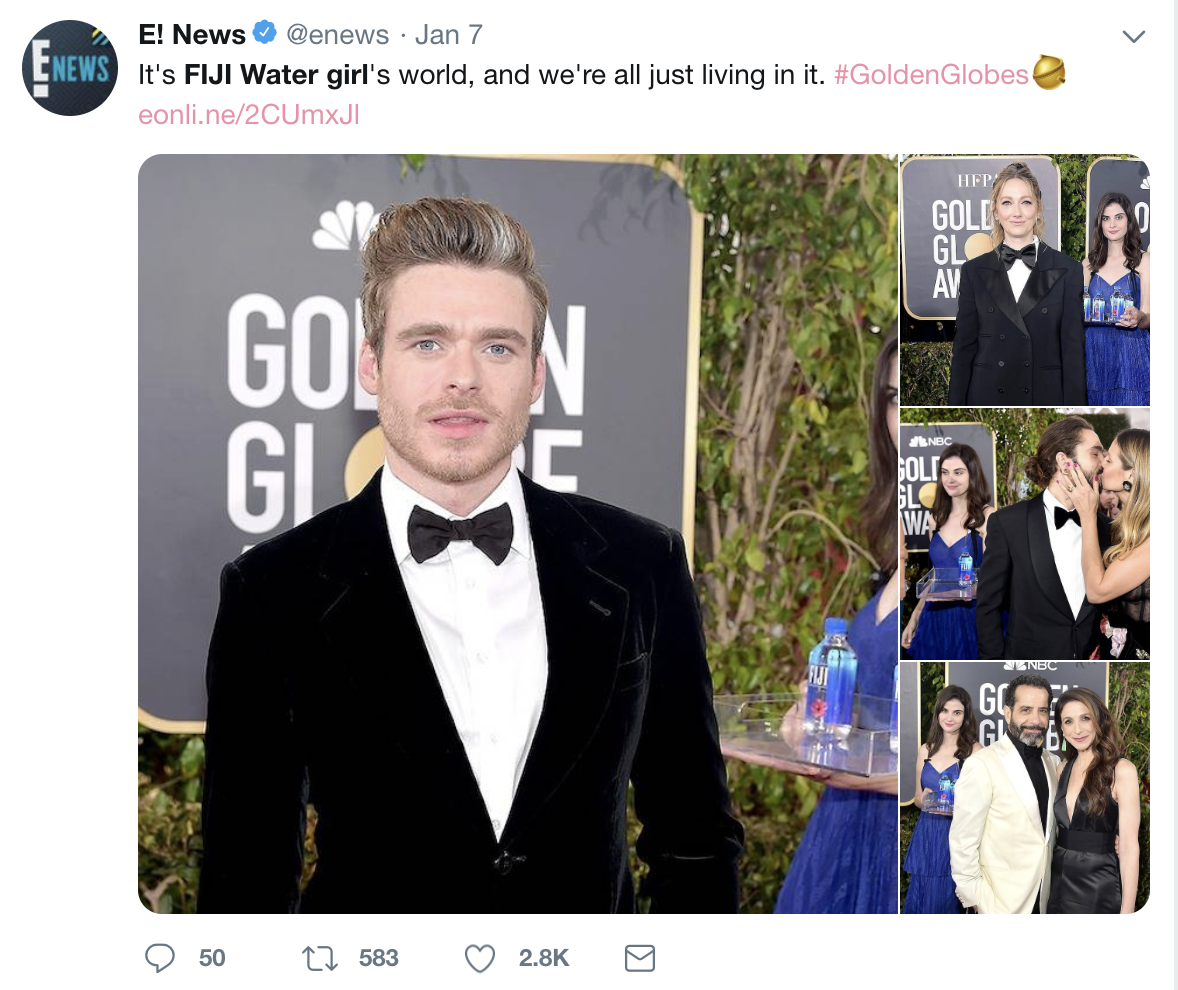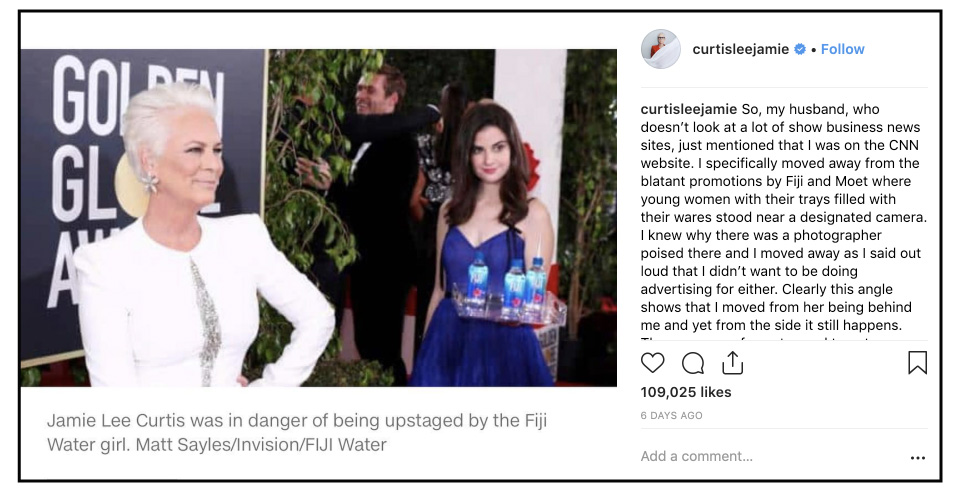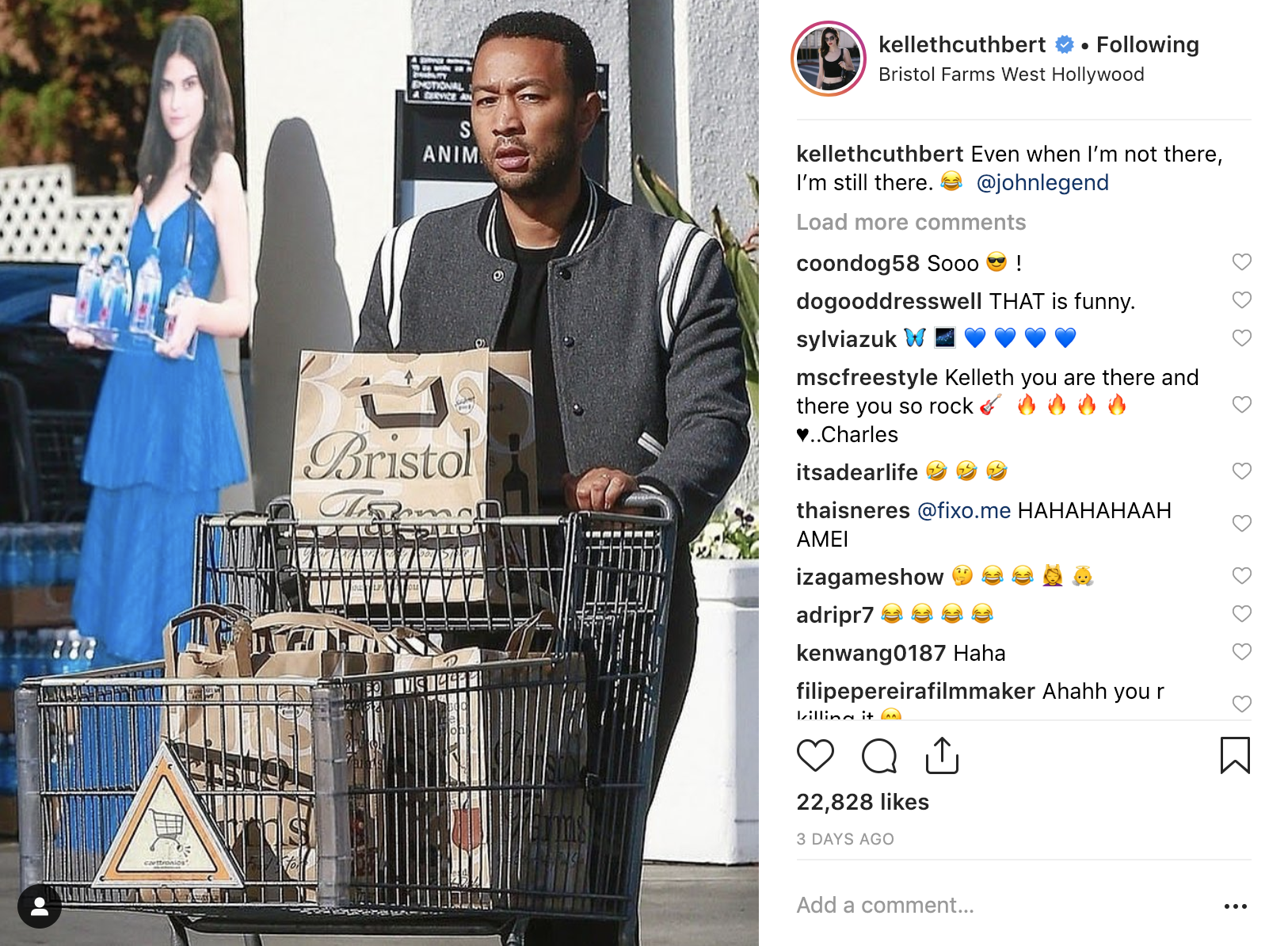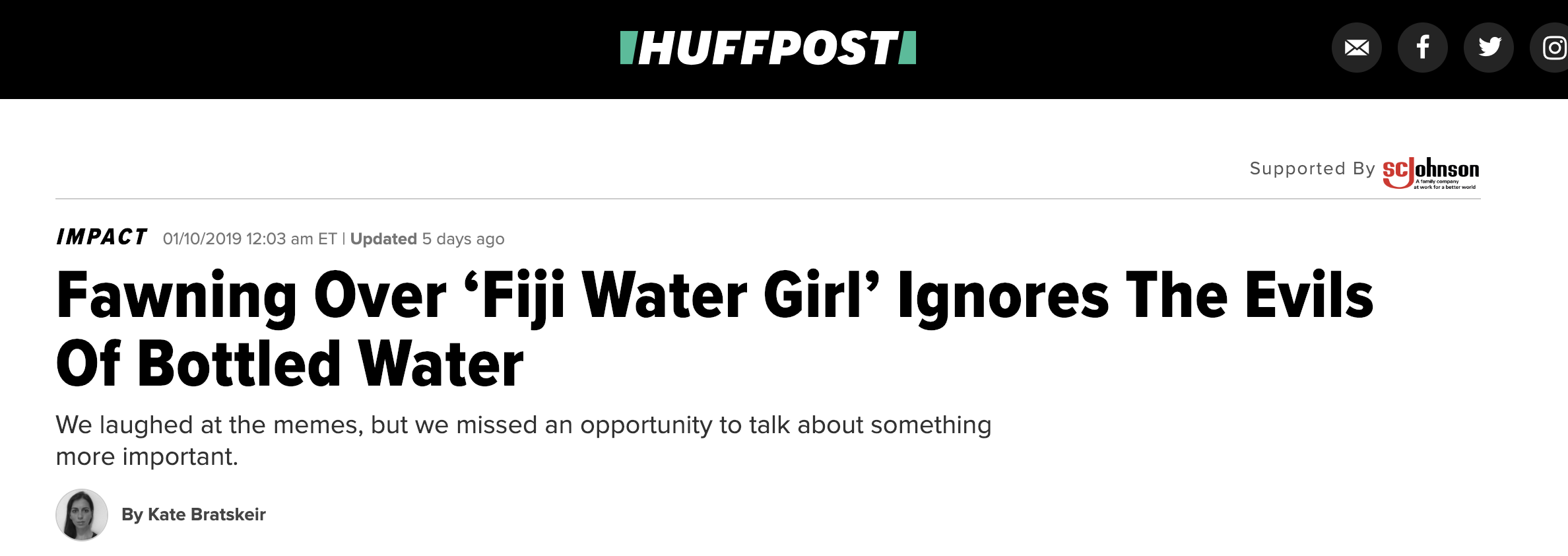11 LESSONS MARKETERS CAN LEARN FROM FIJI WATER’S GOLDEN GLOBES PHOTOBOMBING
Who was the most photographed and talked about person at the 2019 Golden Globe Awards? Canadian model Kelleth Cuthbert, who was hired by Fiji Water to photobomb celebrities such as Heidi Klum, Idris Elba and Nicole Kidman on the Globes’ Red Carpet by smiling coyly at the camera while holding a tray of Fiji water bottles alongside the superstars.
What’s more, the second most popular hashtag of the event, after #GoldenGlobes, was #Fijiwatergirl – a tag used more than 7,000 times within hours of the opening of the broadcast. The Fiji Water Girl photobombing stunt, according to BrandWatch, generated a staggering 98.9 million impressions on Twitter alone – resulting in what Apex estimated was $12 million in ad value from the online and media conversations. “From a branding and marketing perspective, the Fiji Water Girl Photobombing Stunt was a combination of product placement and social media brilliance,” concludes Stacey Hintermeister, Group Director at the Minneapolis agency CBX. “Brands across the globe dream of the kind of content that the Golden Globes’ night created for Fiji; it was funny, well-played and iconic.”

With the insane levels of engagement, buzz and transformation of the brand into a social media phenomenon, here are 11 lessons that marketers can take from Fiji Water’s Golden Globes success:
1 – Brands Must Seize the Organic Moment Via Social
Although it’s unclear how much of the Fiji Water Girl stunt was planned in advance (it appears that the photographer hired by Fiji improvised when that evening proved too cold for celebrities to be photographed drinking the Fiji Water), it’s just as clear that a willingness by Fiji Water to go with the flow and take risks with circumstances on the Red Carpet played a big part in the stunt going viral. “We’re so glad everyone is talking about our water!,” tweeted Fiji Water about their model, seemingly a bit surprised by their own success, “(senses ominous presence) She’s right behind us isn’t she?” Within days, Fiji Water was tweeting out movie scenes from “Rocky” to “Star Wars,” in which their Fiji Girl appeared to hover behind actors Sylvester Stallone and Mark Hamill. Intriguingly, where other brands would be offering their spokespeople for interviews, Fiji Water’s PR staff let the stunt speak for itself. “Fiji Water has not yet responded to Adweek’s request for comment about its viral water tray holder,” the trade magazine reported. “The Wonderful Company (Fiji’s owner) couldn’t immediately be reached for comment,” reported USA Today. Corporate-speak never intruded and official spokespeople were absent – which made Fiji’s entire campaign feel more organic and authentic.
2 – Surprise! Publicity Stunts Still Work In The Digital Age
“Every bottled water company wants to brand their water as unique and special, because the truth is no bottled water is unique or special,” writes Peter Gleick, author of “The World’s Water, Bottled and Sold: The Story Behind Our Obsession With Bottled Water.” As an agency that’s performed our share of branded publicity stunts (from carving then-Gov. Jesse Ventura out of 5,000 pounds of Kemps ice cream to unveiling the World’s Largest Rubberband Ball for OfficeMax), it’s clear that an old-school publicity stunt like hiring a woman to stand behind a celebrity was a bold way to make the Fiji Water brand stand out in the $18.5 billion bottled water category. But the stunt was just the diving board for Fiji, a platform that enabled consumers to interact with Fiji Water’s playful, snarky content through social media.
3 – Jamie Lee Curtis Won’t Be Drinking Fiji Water
Not everyone in Hollywood was enamored of the Fiji Water Girl brand activation. Actress Jamie Lee Curtis, captured on camera with the Fiji Girl in the frame, angrily commented that she “moved away from the blatant promotions by Fiji and Moet, where young women with their trays filled with their wares stood near a designated camera. I knew why there was a photographer positioned there and I moved away as I said out loud that I didn’t want to be doing advertising for either.” Would the public empathize with celebrities who felt their presence was an implied endorsement of the brand, and perhaps blow back against Fiji Water? Not according to CBX agency’s Hintermeister: “Jamie Lee Curtis’ reference to the stunt as a product endorsement by celebrities is a misconception, at best. The photos in no way imply that any of the subjects in the photo are endorsing the products; instead, it was a case of ‘right place, right time’ by the Fiji water girl.”
Matt Kelly, co-founding partner at the Twin Cities experiential marketing agency Street Factory, adds: “Curtis absolutely has the right to protect herself from misleading endorsements, but this is the Golden Globes – a highly commercialized space. Jamie Lee Curtis’ response seems to have amplified the awareness of Fiji Water’s stunt, so that may have backfired on her a bit. We were just at CES executing a campaign for one of our clients. Kanye West and his entourage came over, and Kanye sat on some furniture that had our client’s branding on it. A social play presented itself right there, but we chose not to use it because it was disingenuous. Kanye was looking for a place to chill – he was not making a product endorsement, and being disingenuous is not what our client is about. Lost opportunity or near miss angering a vocal celebrity?”

4 – Expect New Rules At Celebrity-Packed Events
Fiji Water has been an official sponsor of the Golden Globes since 2015, so they didn’t exactly “crash” the event. But you can expect that the attorneys representing the Globes – and the Oscars, Emmys, Tony’s, Grammy’s and Maccabees (we made the last one up) – are already instituting strict new guidelines for how celebrity participants can be leveraged by event sponsors and what brands can and cannot do during the broadcasts. “The sponsors of events need to get permission from people when they get them to take their picture next to products,” argued actress Curtis, laying out what is likely to become known in Hollywood as The Curtis Rule in future award event contracts.
5 – From Red Carpet to Retail
Less than a week after the 2019 Golden Globes, John Legend was photographed leaving a supermarket in Beverly Hills, a cardboard cutout of the Fiji Water Girl visible behind him in the shot. In a perfect marketing world, every C-store and supermarket in America would have a Fiji girl end-cap, floor decal or point-of-purchase stand-up to help consumers make the connection between the Fiji Girl Golden Globes meme and the Fiji bottles for sale in their local grocery store. “The stunt did drive conversation, i.e., TV/internet/social, so it performed on brand awareness,” grants Kelly of Street Factory Media. “The million-dollar question is; did this translate into incremental sales? Unless Fiji Water has tools and controls in place to measure an uptick in sales they are able to directly attribute to the stunt – nobody knows. The easier to measure value would be found in the PR and social chatter, which I imagine is exactly what they were going for.”
6 – Your Package Design Just Became Mission Critical
As many food and beverage purchases move out of brick-and-mortar supermarkets into subscription delivery (such as Blue Plate and Hello Fresh) and online (i.e., AmazonFresh), did anyone predict that your product’s packaging would remain so critical? Yet, the success or failure of Fiji’s photobombing campaign will rise or fall at point-of-sale when the hands of thirsty consumers reach either for a container of Evian, Dasani, Aquafina . . . or the iconic square bottles of Fiji Water. Each of the socially-shared images of Fiji Girl’s tray hammered home the visuals of the product’s external packaging, which given that Fiji’s actual product (water) is colorless, odorless and to all extent invisible, is of vital importance.
7 – Brand Marketers Can’t Control The Fans – And That’s A Good Thing
The liveliest tweets generated by the Fiji Water Girl’s campaign were from anonymous fans; the brand stayed out of their customers’ way. My favorite comment about this year’s Golden Globes: “It’s a shame they had some awards ceremony interrupting the Fiji Water Girl show!”
8 – Talent Really Matters with Event Marketing Stunts
Whether your brand team is hiring guerrilla street samplers, actors, mimes, musical talent or street magicians to make your product mysteriously appear in consumers’ hands, the success of Fiji Water’s campaign proves that choosing the right talent for experiential or event marketing is critical. When we sent America’s #1 Groucho Marx impersonator across the country to promote Malt-O-Meal Cereal, the campaign’s success hinged upon the wit of the talent recreating the comedian. Our actor was so successful, at least one radio host clearly believed that he was not interviewing a Groucho Marx impersonator, but in fact the real Groucho Marx – who had died decades before. Note: Fiji Water had hired four female models dressed in nearly identical blue gowns to display the product. Only one – Kelleth Cuthbert – had the poses and self-proclaimed “sultry look” that broke the internet. “There’s tons of photographers everywhere,” marveled Cuthbert to People magazine after the Globes. “It doesn’t matter where you stand, you’re in the crossfire of every shot. You gotta have good face, at least, if you’re gonna be hovering in the background frequently.”
9 – Fiji Water Model Kelleth Cuthbert’s Price Just Went Up
Trust us on this one. She’s coming soon to a movie theatre near you. Without a water bottle.
10 – Recognizing The Challenges of Engaging With The Public
In the wake of Fiji Girl, a Huffington Post columnist (below) hammered Fiji Water, which is shipped from the South Pacific Ocean island of Fiji, for being eco-unfriendly and energy-wasteful given its large carbon footprint. Social commentators brought up the World Health Organization’s finding that 90% of bottled water brands contain microplastic contamination. And environmentalists on Twitter noted that half of Fijians live without access to clean water – highlighting claims that “Americans, who live an entire ocean and several continents away from Fiji, can access Fijian water more easily than the Fijian people.” When a brand hurls itself into the public square, it must be ready to engage with criticism of its record of environmental, employment, diversity, marketing and other practices. That’s why PR agencies were invented.
11 – Replicating The Fiji Water Girl’s Success
Finally, if there’s one thing Hollywood understands, it’s that every successful movie inspires an inevitable series of knockoffs – Clint Eastwood’s sublime “Unforgiven” spawned a dozen bad cowboy movies. With the 2019 Academy Awards (the Oscars) airing on February 24, don’t be surprised to see Doritos, Oreos, Domino’s Pizza or other consumer brands frantically trying to create their own version of the Fiji Water Girl’s photobombing stunt. Look out, Oscar!
So, before your Chief Marketing Officer runs into your office and begs you to concoct a Fiji Water Girl-style stunt to promote your company’s product, keep these lessons in mind and learn from what Fiji Water did right (and wrong).





